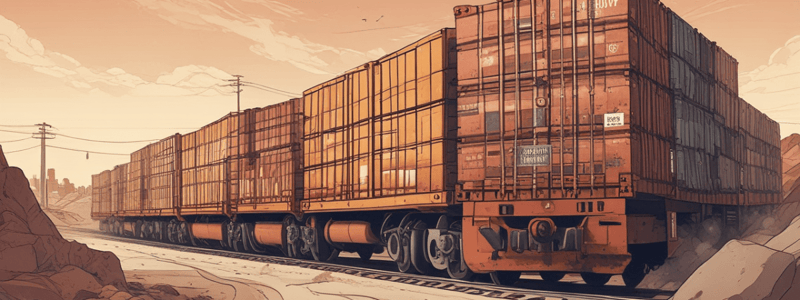Podcast
Questions and Answers
What is the primary purpose of channels of distribution?
What is the primary purpose of channels of distribution?
- To promote goods and services
- To move goods and services from the producer to the consumer (correct)
- To finance goods and services
- To produce goods and services
Which type of channel is most appropriate when a producer wants to maintain control over the distribution process?
Which type of channel is most appropriate when a producer wants to maintain control over the distribution process?
- Indirect channel
- Broker channel
- Direct channel (correct)
- Wholesaler channel
Which of the following transportation systems is used for the movement of goods over long distances?
Which of the following transportation systems is used for the movement of goods over long distances?
- Water transportation
- Air transportation
- Motor transportation
- Rail transportation (correct)
What type of storage is used for perishable goods?
What type of storage is used for perishable goods?
What is the primary purpose of a distribution center?
What is the primary purpose of a distribution center?
Which of the following is a characteristic of an indirect channel of distribution?
Which of the following is a characteristic of an indirect channel of distribution?
What is the primary purpose of a warehouse in the distribution process?
What is the primary purpose of a warehouse in the distribution process?
Which mode of transportation is most suitable for transporting perishable goods?
Which mode of transportation is most suitable for transporting perishable goods?
What is the primary function of a broker in the distribution process?
What is the primary function of a broker in the distribution process?
Which type of storage is used for storing large quantities of goods?
Which type of storage is used for storing large quantities of goods?
What is the primary advantage of using a direct channel of distribution?
What is the primary advantage of using a direct channel of distribution?
Which type of warehousing option is typically used by multiple companies to store their goods?
Which type of warehousing option is typically used by multiple companies to store their goods?
What is the primary function of an agent in the distribution process?
What is the primary function of an agent in the distribution process?
Which type of transportation system is most suitable for transporting goods over short distances?
Which type of transportation system is most suitable for transporting goods over short distances?
What is the primary purpose of shipping and receiving processes in the distribution channel?
What is the primary purpose of shipping and receiving processes in the distribution channel?
Flashcards are hidden until you start studying
Study Notes
Channels of Distribution
- Definition of Distribution: The process of moving goods, products, or services from the producer to the end consumer, involving a network of intermediaries, transportation, and storage.
Types of Distribution Channels
- Direct Channel: A direct link between the producer and the end consumer, no intermediaries involved.
- Indirect Channel: Involves one or more intermediaries, such as wholesalers, agents, or brokers, between the producer and the end consumer.
Choosing the Right Distribution Channel
- Direct Channel: Suitable for products that require high customer interaction, personalized service, or have a high value.
- Indirect Channel: Suitable for products that require wide distribution, have a low unit value, or require specialized services.
Shipping and Receiving Processes
- Transportation Modes: Motor, rail, water, and air transportation systems used to move goods from one location to another.
- Receiving Process: Involves inspecting, storing, and processing shipments upon arrival.
Storing and Warehousing Options
- Cold Storage: Specialized storage for perishable items, such as food and pharmaceuticals, requiring controlled temperatures.
- Commodity Storage: Storage for bulk commodities, such as grains, metals, or oil.
- Bulk Storage: Storage for large quantities of products, such as furniture or machinery.
- Distribution Centers: Centralized warehouses for efficient storage, picking, and shipping of products.
- Public Warehousing: Shared storage facilities for multiple companies, offering flexible storage options.
- Private Warehousing: Dedicated storage facilities for a single company, offering tailored storage solutions.
Channels of Distribution
- Definition of Distribution: The process of moving goods, products, or services from the producer to the end consumer, involving a network of intermediaries, transportation, and storage.
Types of Distribution Channels
- Direct Channel: A direct link between the producer and the end consumer, no intermediaries involved.
- Indirect Channel: Involves one or more intermediaries, such as wholesalers, agents, or brokers, between the producer and the end consumer.
Choosing the Right Distribution Channel
- Direct Channel: Suitable for products that require high customer interaction, personalized service, or have a high value.
- Indirect Channel: Suitable for products that require wide distribution, have a low unit value, or require specialized services.
Shipping and Receiving Processes
- Transportation Modes: Motor, rail, water, and air transportation systems used to move goods from one location to another.
- Receiving Process: Involves inspecting, storing, and processing shipments upon arrival.
Storing and Warehousing Options
- Cold Storage: Specialized storage for perishable items, such as food and pharmaceuticals, requiring controlled temperatures.
- Commodity Storage: Storage for bulk commodities, such as grains, metals, or oil.
- Bulk Storage: Storage for large quantities of products, such as furniture or machinery.
- Distribution Centers: Centralized warehouses for efficient storage, picking, and shipping of products.
- Public Warehousing: Shared storage facilities for multiple companies, offering flexible storage options.
- Private Warehousing: Dedicated storage facilities for a single company, offering tailored storage solutions.
Channels of Distribution
- Definition of Distribution: The process of moving goods, products, or services from the producer to the end consumer, involving a network of intermediaries, transportation, and storage.
Types of Distribution Channels
- Direct Channel: A direct link between the producer and the end consumer, no intermediaries involved.
- Indirect Channel: Involves one or more intermediaries, such as wholesalers, agents, or brokers, between the producer and the end consumer.
Choosing the Right Distribution Channel
- Direct Channel: Suitable for products that require high customer interaction, personalized service, or have a high value.
- Indirect Channel: Suitable for products that require wide distribution, have a low unit value, or require specialized services.
Shipping and Receiving Processes
- Transportation Modes: Motor, rail, water, and air transportation systems used to move goods from one location to another.
- Receiving Process: Involves inspecting, storing, and processing shipments upon arrival.
Storing and Warehousing Options
- Cold Storage: Specialized storage for perishable items, such as food and pharmaceuticals, requiring controlled temperatures.
- Commodity Storage: Storage for bulk commodities, such as grains, metals, or oil.
- Bulk Storage: Storage for large quantities of products, such as furniture or machinery.
- Distribution Centers: Centralized warehouses for efficient storage, picking, and shipping of products.
- Public Warehousing: Shared storage facilities for multiple companies, offering flexible storage options.
- Private Warehousing: Dedicated storage facilities for a single company, offering tailored storage solutions.
Studying That Suits You
Use AI to generate personalized quizzes and flashcards to suit your learning preferences.




